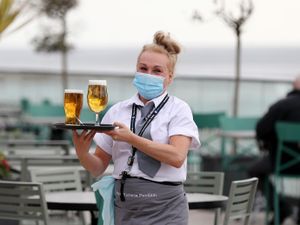Services sector reaches pre-pandemic levels despite GDP slowdown
Economic growth slowed from 0.6% in September to 0.1% in October, the Office for National Statistics said.

The UK’s all-important services sector has finally bounced back to where it was nearly two years ago before the pandemic hit, an official estimate has shown.
While the rate of economic growth slowed down in October, the services sector, which includes everything from restaurants to accountants, managed to reach its February 2020 levels again for the first time.
The recovery is, however, running at two speeds. Consumer-facing services, such as restaurants, are still 5.2% below their pre-pandemic levels, while all other services are 1.4% ahead.
The news came as the Office for National Statistics (ONS) revealed that gross domestic product (GDP), a key measure of the economy, rose by 0.1% in October.
It is a marked slowdown since September when the economy grew by 0.6%, according to ONS figures.
It is also well below the 0.4% growth that analysts had forecast, according to a consensus provided by Pantheon Macroeconomics.
It raises further fears for what might happen in data released in the months ahead, as the Omicron variant is likely to put a further dampener on the economy.
Trades Union Congress boss Frances O’Grady said that the figures show that even before new restrictions were announced earlier this week, the UK’s recovery was “in the slow lane.”
She called on ministers to bring back to furlough scheme to protect jobs.
Production output decreased by 0.6% in October 2021, with electricity and gas down by 2.9%, and mining and quarrying down by 5.0%.
A 0.6% drop in production output, due in part to the energy and mining sectors, and a 1.8% fall in construction, contributed to the slowdown.
GDP remains 0.5% below its February 2020 levels.
“While GDP growth slowed in October the UK health sector again grew strongly while second-hand car sales and employment agencies also boosted the economy,” said ONS chief economist Grant Fitzner.
“Taken as a whole, the dominant services sector reached its pre-pandemic level for the first time in 20 months.
“These gains were offset by a drop in restaurants, which fell back after a strong summer, and reduced oil extraction and gas use.
“Construction also saw its biggest drop since April last year, with notable falls in housebuilding and infrastructure work, partly driven by shortages in raw materials.”
Chancellor Rishi Sunak said: “We’ve always acknowledged there could be bumps on our road to recovery, but the early actions we have taken, our ongoing £400 billion economic support package and our vaccine programme mean we are well placed to keep our economy on track.
“We have still been recovering quicker than expected, with more employees on payrolls than ever before and redundancies remaining low.”
Labour’s shadow chief secretary to the Treasury Pat McFadden said: “Today’s figures are extremely concerning. Taxpayers are paying the price for 11 years of low economic growth under the Tories.
“If the Tories had managed to match Labour’s record on economic growth – even taking account of the financial crisis – we wouldn’t be trapped in this cycle of high taxes and low growth which is leaving working people paying the price.”
Alpesh Paleja, lead economist at the Confederation of British Industry, said: “Growth disappointed in October, reinforcing concerns about the resilience of the UK’s economic recovery to the Omicron variant and the impact of further restrictions.
“We need to create consistency in our approach and build confidence by reducing the oscillation between normal life and restrictions as we learn to live with the virus and its variants.”
Separately the ONS also released trade figures for October, showing that imports dropped by £400 million, or 1.1%, while exports rose by a similar amount.
“Brexit continues to hold back exports,” said Pantheon Macroeconomics’ senior UK economist Gabriella Dickens.
The value of exported goods is still around 8% lower than 2018 levels, and is likely to flatline in coming months, she added.





